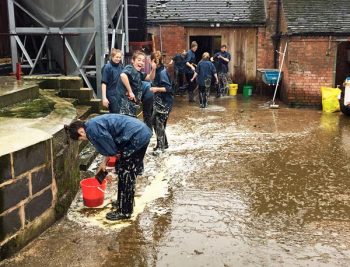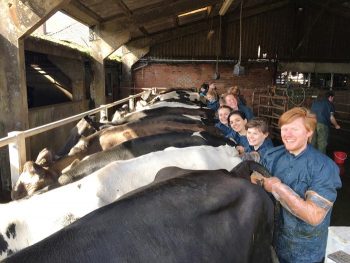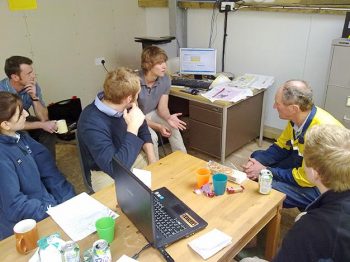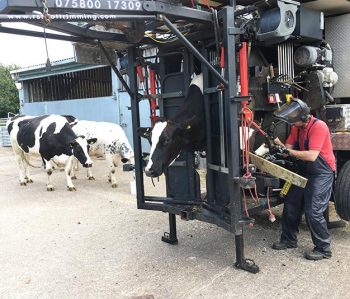16 Oct 2017
Reluctant hero: veterinary role in on-farm biosecurity
Wendela Wapenaar details the importance of knowledge and communication when working with farmers to improve animal health.

On a recent telephone call to my family in the Netherlands, I was speaking to my aunt and uncle, who are nearly retired dairy farmers. They mentioned how disappointing it was the livestock markets in their area were not “what they used to be”; a few kids were still showing youngstock, but the majority of stalls were taken up by local farm producers selling cheese, honey and various other products, instead of lots of cattle on show and for sale.

We compared it to the situation in the UK and they were surprised we still had so many animal movements here; although they don’t like the change in their system, they do recognise bringing together livestock in sometimes stressful situations and taking them back to various places is a high risk for transmitting endemic diseases. In the end, they need to make a living on their farm and healthy livestock is a prerequisite.
To me, this conversation highlighted the importance of communication; vets, farmers and the public want the same thing – a healthy and productive herd. Partly due to everyone’s individual background, we have a different understanding of how we can achieve this.
Variability exists between farmers, but also between vets (Cresswell et al, 2013). No one right way of doing things exists, but a preferred way for one particular farm may. This not only depends on quantitative characteristics, such as prevalence of disease, but perhaps even more so on the goals and intentions of the farmer.
How ambitious or risk averse are they? What are their practical and financial possibilities? What are their goals on the farm? Do they want to take cattle to shows, export them, or achieve the highest health status and set their farm up successfully for the next generation?
Challenges
To have a conversation about biosecurity and a farmer’s ambitions is challenging; the consequences of the national bTB control programme may be superseding the objectives farmers have and make them feel “out of control” and, sometimes, vets get sucked in by this feeling farmers have.
However, with movement of animals across the UK and the intention to reduce antimicrobial use in food-producing animals, increased biosecurity is more important than ever, as highlighted by both the farming and veterinary press (Price, 2017; Veterinary Times, 2017).

Biosecurity measures can include management changes that will affect general disease transmission, which will help reduce bTB, as well as other endemic diseases. This is not a novelty to us, but research shows vets are not seen as the most common advocates of biosecurity, as we’ll hear in the presentation taking place at BCVA Congress soon.
Farmers trust their vet and, besides that, who else is better placed to talk about biosecurity?
Research
Research funded over the past six years by the Agriculture and Horticulture Development Board (AHDB) Dairy, The University of Nottingham and the Centre for Evidence-based Veterinary Medicine has uncovered some of the issues around the use of biosecurity and vaccination on dairy cattle farms in Great Britain (Richens et al, 2015; Ruston et al, 2016; Shortall et al, 2016; Richens et al, 2016; Brennan et al, 2016; Shortall et al, 2017).
This work indicated vet advice on, and/or conversations around, biosecurity do not commonly occur and discussions are infrequently initiated by vets. When farmers were asked who thought it was important they implemented biosecurity measures on their farms, their own vet ranked fourth (57.7%) after their milk buyer (72.2%), Defra (69.9%) and AHDB Dairy (62.4%).
However, this changed when asked about whose opinion was important to them regarding the implementation of biosecurity measures on their farm, with vets ranked second (82.1%) after their milk buyer (83.2%).

Using health psychology models, such as the transtheoretical model of behaviour change (Prochaska and DiClemente, 1982), the research indicates an opportunity exists for vets to focus their attention on specific practices already being considered by farmers, instead of those not in the forefront of farmers’ minds, to improve the chances of successfully enacting change.
Future work
The finding dairy farmers do not necessarily perceive vets as primary advocates of them undertaking on-farm biosecurity measures is surprising, given the body of literature that identifies farmers look to them for guidance about animal health issues (Brennan and Christley, 2013; Enticott et al, 2012).
Work clearly needs to be done here, highlighting to farmers that improving on-farm biosecurity is prioritised by farm animal vets. As farmers feel vets clearly have a role, the opportunity to develop these discussions is key.
We know vets would like more evidence of what is effective as a biosecurity measure; an appetite exists in the research domain to investigate this, but the practicalities are challenging to carry out research that could truly identify the effect of specific measures, such as wearing farm clothing, cleaning equipment, buying in stock from known disease status herds or maintaining farm boundaries.
However, why not give it a try, discuss options with farmers and consider buying a set of boots and coveralls for on-farm visitors, which is common practice in the Netherlands? As vets, we need to set the standard – it is somewhat analogous to teaching vet students. We show them the gold standard where possible (Figure 1), expecting them, once in practice, to likely forget some things you taught, but still deliver key components.
Education

During their training at vet school, we talk about biosecurity many times and aim to set the right example (Figure 2) when going on to farm –right from their first animal handling practical in first year. We try hard to teach communication (Figure 3) and business skills, and explain to our graduates they sell the five years of knowledge and skills they have gained, and not rely on their ability to sell vaccines or antibiotics.
As vets, we have a unique skillset farmers appreciate and, although we want to be their preferred vet, we also need to deliver less popular messages to help them move forward. We can all think of areas around hygiene that are important, but sometimes tricky to communicate. However, if we don’t, someone else may do it for us; the world is changing and we need to move with it if we want to stay at the forefront of livestock health (Figure 4).
Some great examples and lots of opportunities exist for vets to engage with – BVD Free, My Healthy Herd, Cattle Health Certification Standards, AHDB Dairy Healthy Feet and Mastitis Control Plan to name a few – and opportunities also exist to improve communication skills to engage with clients in these more tricky situations, such as during BCVA Congress workshops and in Bard et al’s article (2017) investigating vet communication in the pursuit of client behaviour change.
The research presented in “The reluctant hero: the role of the vet in on-farm biosecurity” highlights the importance of interpersonal/communication skills in addition to knowledge when endeavouring to work alongside farmers to improve animal health and productivity.
Latest news

